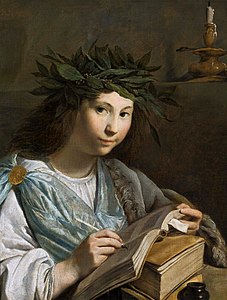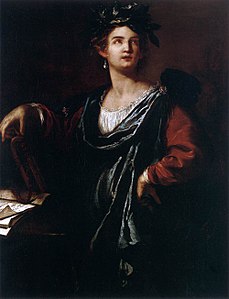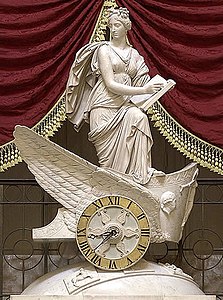Clio
| Clio | |
|---|---|
Goddess of history and lyre playing | |
| Member of The Muses | |
 Clio on an antique fresco from Pompeii | |
| Abode | Mount Olympus |
| Symbols | Scrolls, books |
| Genealogy | |
| Parents | Zeus and Mnemosyne |
| Siblings | Euterpe, Polyhymnia, Urania, Calliope, Erato, Thalia, Terpsichore, Melpomene and several paternal half-siblings |
| Consort | Pierus |
| Children | Hymenaeus, Hyacinthus |

In Greek mythology, Clio (traditionally /ˈklaɪoʊ/,[2] but now more frequently /ˈkliːoʊ/; Greek: Κλειώ), also spelled Kleio, Сleio, or Cleo,[3] is the muse of history,[4] or in a few mythological accounts, the muse of lyre-playing.[5]
Etymology
[edit]Clio's name is etymologically derived from the Greek root κλέω/κλείω (meaning "to recount", "to make famous" or "to celebrate").[6][7][8] The name's traditional Latinisation is Clio,[9] but some modern systems such as the American Library Association-Library of Congress system use K to represent the original Greek kappa, and ei to represent the diphthong ει (epsilon iota), thus Kleio.
Depiction
[edit]Clio, sometimes referred to as "the Proclaimer", is often represented with an open parchment scroll, a book, or a set of tablets.[10] She is also shown with the heroic trumpet and the clepsydra (water clock).[11] Cesare Ripa's Iconologia, an important source book for artists of the Baroque period, stated that Clio should be depicted with a crown of laurels, a trumpet and an open book.[12]
Mythology
[edit]Like all the muses, Clio is a daughter of Zeus and the Titaness Mnemosyne, goddess of memory. Along with her sister Muses, she is considered to dwell at either Mount Helicon or Mount Parnassos.[4] Other common locations for the Muses are Pieria in Thessaly, near to Mount Olympus.[5]
She had one son, Hyacinth, with one of several kings, in various myths—with Pierus or with king Oebalus of Sparta, or with king Amyclas,[13][14] progenitor of the people of Amyclae, dwellers about Sparta. In a scholium to Euripides' Rhesus, she is also the mother of Hymenaeus and Rhesus.[15] According to Apollodorus, Clio was made to fall in love with Pierus by Aphrodite, for Clio had derided her for her love affair with Adonis.[16] Other accounts credit her as the mother of Linus by Magnes, a poet who was buried at Argos, although Linus has a number of differing parents depending upon the account, including several accounts in which he is the son of Clio's sisters Urania or Calliope.[17]
Legacy
[edit]In her capacity as "the proclaimer, glorifier and celebrator of history, great deeds and accomplishments"[18] Clio is used in the name of various modern brands, including the Clio Awards for excellence in advertising.
The Cambridge University History Society is informally referred to as Clio; the Cleo of Alpha Chi society at Trinity College, Connecticut, is named after the muse. Likewise, the undergraduate student outreach group for the Penn Museum at the University of Pennsylvania is known as the Clio Society, and the first sorority founded at SUNY Geneseo, Phi Kappa Pi, began as the Alpha Clionian literary society. "Clio" also represents history in some coined words in academic usage: cliometrics, cliodynamics.
Clio Bay in Antarctica is named after the muse.
Gallery
[edit]-
Statue of Clio by Albert Wolff in Berlin
-
Clio, Muse of History by Johannes Moreelse
-
Clio, the Muse of History (1632) by Artemisia Gentileschi.
-
The Muse Clio (c. 1689) by Pierre Mignard
-
The Muse Clio by Bernhard Rode
-
Clio, Muse of History (1800) by Charles Meynier
-
Car of History, a chariot clock depicting Clio, by Carlo Franzoni, 1819, in National Statuary Hall
-
Sculpture of Clio by Alexander Stirling Calder on the tomb of historian Henry Charles Lea
See also
[edit]Notes
[edit]- ^ "Clio". lib.ugent.be. Retrieved 2020-09-28.
- ^ Avery, Catherine B., ed. (1962). New Century Classical Handbook. New York: Appleton-Century-Crofts. p. 304.
- ^ Harvey, Paul (1984). "Clio/Kleio". The Oxford Companion to Classical Literature (Revised 1984 ed.). Oxford: Oxford University Press. p. 110. ISBN 0-19-281490-7.
- ^ a b Leeming, David (2005). "Muses". The Oxford Companion to World Mythology. Oxford University Press. p. 274. ISBN 978-0-19-515669-0.
- ^ a b Morford, Mark P. O.; Lenardon, Robert J. (1971). Classical Mythology. New York: David McKay Company. pp. 56–57. ISBN 0-679-30028-7.
- ^ D. S. Levene, Damien P. Nelis (2002). Clio and the Poets: Augustan Poetry and the Traditions of Ancient Historiography. Brill Academic Publishers. ISBN 90-04-11782-2.
- ^ Κλειώ. Liddell, Henry George; Scott, Robert; A Greek–English Lexicon at the Perseus Project
- ^ κλειώ. Liddell, Henry George; Scott, Robert; A Greek–English Lexicon at the Perseus Project
- ^ Lewis and Short, A Latin Dictionary: Founded on Andrews' Edition of Freund's Latin Dictionary: Revised, Enlarged, and in Great Part Rewritten by Charlton T. Lewis, Ph.D. and Charles Short, LL.D. The Clarendon Press, Oxford, 1879, s.v.
- ^ "Car of History Clock | Architect of the Capitol". aoc.gov. Retrieved 2023-09-05.
- ^ "Clio, Greek Muse". Britannica. Encyclopædia Britannica, Inc. Retrieved 6 May 2023.
- ^ Ripa, Cesare (1611). Iconologia (in Italian).
- ^ Apollodorus, 3.10.3
- ^ Pausanias, 3.1.3 & 3.19.4
- ^ Brill's New Pauly, s.v. Cleio; Scholia on Euripides' Rhesus, 346.
- ^ Apollodorus, 1.3.3
- ^ Graves, Robert (1960). The Greek Myths. Vol. 2 (1960 revised ed.). London: Penguin. pp. 212–213.
- ^ Carder, Sheri: "Clio Awards" The Guide to United States popular culture, pages 180–181, ISBN 978-0-87972-821-2
References
[edit]- Apollodorus, The Library with an English Translation by Sir James George Frazer, F.B.A., F.R.S. in 2 Volumes, Cambridge, MA, Harvard University Press; London, William Heinemann Ltd. 1921. ISBN 0-674-99135-4. Online version at the Perseus Digital Library. Greek text available from the same website.
- Brill’s New Pauly: Encyclopaedia of the Ancient World. Antiquity, Volume 3, Cat-Cyp, editors: Hubert Cancik, Helmuth Schneider, Brill, 2003. ISBN 978-90-04-12266-6. Online version at Brill.
- Pausanias, Description of Greece with an English Translation by W.H.S. Jones, Litt.D., and H.A. Ormerod, M.A., in 4 Volumes. Cambridge, MA, Harvard University Press; London, William Heinemann Ltd. 1918. ISBN 0-674-99328-4. Online version at the Perseus Digital Library
- Pausanias, Graeciae Descriptio. 3 vols. Leipzig, Teubner. 1903. Greek text available at the Perseus Digital Library.
Further reading
[edit]- Bartelink, Dr. G. J. M. (1988). Prisma van de mythologie. Utrecht: Het Spectrum.
- van Aken, Dr. A. R. A. (1961). Elseviers Mythologische Encyclopedie. Amsterdam: Elsevier.








